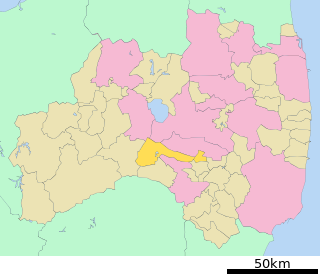
Fukushima is the capital city of Fukushima Prefecture, Japan. It is located in the northern part of the Nakadōri, central region of the prefecture. As of 1 May 2021, the city has an estimated population of 283,742 in 122,130 households and a population density of 370 inhabitants per square kilometre (960/sq mi). The total area of the city is 767.72 square kilometres (296.42 sq mi).

Shirakawa is a city located in Fukushima Prefecture, Japan. As of 1 April 2020, the city had an estimated population of 59,393 in 23,546 households and a population density of 190 persons per km2. The total area of the city was 305.3 square kilometres (117.9 sq mi).

Sukagawa is a city located in Fukushima Prefecture, Japan. As of 1 May 2018, the city had an estimated population of 76,251 in 38824 households, and a population density of 270 persons per km2. The total area of the city was 279.43 square kilometres (107.9 sq mi).

Nihonmatsu is a city in Fukushima Prefecture, Japan. As of 1 April 2020, the city has an estimated population of 54,013 in 20,179 households, and a population density of 160 persons per km2. The total area of the city was 344.42 square kilometres (132.98 sq mi). The Adachi neighborhood of Nihonmatsu was the birthplace of artist Chieko Takamura, subject of the book of poems Chieko's Sky, written by her husband Kōtarō Takamura.

Shitara is a town located in Kitashitara District, Aichi Prefecture, Japan. As of 1 October 2019, the town had an estimated population of 4,531 in 2,133 households, and a population density of 16.5 persons per km². The total area of the town was 273.94 square kilometres (105.77 sq mi).

Kagamiishi is a town located in Fukushima Prefecture, Japan. As of 1 March 2020, the town had an estimated population of 12,272 in 4434 households, and a population density of 390 persons per km². The total area of the town was 31.30 square kilometres (12.08 sq mi)..

Iwase was a village located in Iwase District, Fukushima Prefecture, Japan.

Ten-ei is a village located in Fukushima Prefecture, Japan. As of 1 January 2020, the village had an estimated population of 5,258 in 1717 households, and a population density of 23 persons per km². The total area of the village was 225.52 square kilometres (87.07 sq mi).

Iwase is a district located in Fukushima Prefecture, Japan.

Tadami is a town located in Fukushima Prefecture, Japan. As of 1 March 2020, the town has an estimated population of 4,117 in 1749 households, of which 45.88% were classified as "elderly households" The town had a population density of 5.5 persons per km2. The total area of the town was 747.56 square kilometres (288.63 sq mi). Tadami is famous locally for its own Snow Festival, where huge sculptures and replicas of monuments are cut out of Tadami's abundant snow.

Inawashiro is a town located in Fukushima Prefecture, Japan. As of 1 March 2020, the town had an estimated population of 13,810 in 5309 households, and a population density of 35 persons per km². The total area of the town was 394.85 square kilometres (152.45 sq mi). It is noted as the birthplace of the famous doctor Hideyo Noguchi, who contributed to knowledge in the fight against syphilis and yellow fever.

Naganuma is a town located in Sorachi Subprefecture, Hokkaido, Japan.

Kōriyama is a city in Fukushima Prefecture, Japan. As of 1 January 2020, the city has an estimated population of 322,996 people in 141760 households, and a population density of 430 persons per km2. The total area of the city is 757.20 square kilometers (292.36 sq mi). Kōriyama is designated as a core city and functions as a commercial center for Fukushima Prefecture. Kōriyama is the third largest conurbation in the Tōhoku region.

Iwaki is a city located in Fukushima Prefecture, Japan. As of 1 April 2020, Iwaki had a population of 337,765 in 143,500 households, and population density of 270 persons per km2. The total area of the city is 1,232.02 square kilometres (475.69 sq mi), making it the largest city in the prefecture and the 10th largest city in Japan (2010) in terms of area. Iwaki is a designated core city, and is also one of the growing number of cities written in hiragana. The present Iwaki City started as the merger of 14 smaller municipalities on October 1, 1966. Every year, Iwaki hosts the Taira Tanabata Festival from 6–8 August.
The Sendaidō (仙台道) was a subroute of the Ōshū Kaidō, one of the Edo Five Routes of Japan. It connected the Ōshū Kaidō's terminus in Shirakawa and Mutsu Province with Sendai. It was established by Tokugawa Ieyasu for government officials traveling through the area.

Inagi-Naganuma Station is a passenger railway station located in the city of Inagi, Tokyo, Japan, operated by East Japan Railway Company.

Cosquín en Japón is a three-day South American folk festival held annually in Kawamata, Fukushima, Japan. The name "Cosquín en Japón" is derived from the Cosquín Festival held in Cosquín, Argentina.

The Fujinuma Dam, was an earth-fill embankment dam in Sukagawa City, Fukushima Prefecture, Japan. It was established on the Ebana River, a tributary of the Abukuma River, 16 km (10 mi) west of the city office of Sukagawa City. Construction on the dam commenced in 1937 and it was completed in 1949 after construction was halted due to World War II. The dam's primary purpose was irrigation. It failed on 11 March 2011 after the 2011 Tōhoku earthquake.
Naganuma Castle (長沼城) was a Japanese castle located in Naganuma, Fukushima Prefecture, Japan. Every year, 300 cherry blossom trees spring into full bloom there.




















